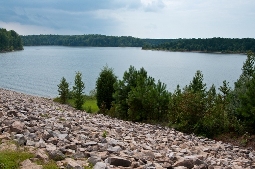Lately, Raleigh residents have been paying more for their water bills. And some haven’t even noticed.
In November, all Raleigh water customers began paying a watershed protection fee. The fee will be used to conserve critical land in the Falls Lake watershed.
According to Ed Buchan, environmental coordinator for Raleigh, the city’s thinking is that “everybody who drinks water benefits from watershed protection and should help protect it.”
Water customers also get something out of the deal: protecting that land could help control future treatment costs for drinking water.
City’s Total Nutrient Fee Budget – $6 million
Total Spent – $4.1 million
Total Spent on Direct Land Acquisition – $3.1 million
Land disturbances such as forestry and construction usually cause an increase in sediment and pollutants flowing into streams and lakes. Sediment reduces the storage capacity of the reservoir, and pollutants must be removed from the water before it is piped to homes and businesses.
The Environmental Protection Agency and American Water Works Association both have found that increasing forest cover in a watershed significantly reduces the cost of water treatment.
The city first began purchasing land and conservation easements — agreements that limit land uses — for this purpose in 2005.
At first, the city added a nutrient management fee to new city sewer connections, generating more than $3.2 million. That revenue was matched 12 to 1 during the past six years by other governments and nonprofits.
But funding for the land program is drying up. Last year, the General Assembly reduced the state’s Clean Water Management Trust Fund from $100 million for the last two years to $11.25 million for 2012 and 2013. In addition, program revenue had fallen off during the recession as new connections to the water supply decreased.
The new fee is expected to generate $1.8 million this year to support the Upper Neuse Clean Water Initiative.
Since November, all customers in Raleigh and Garner have paid 10 cents per thousand gallons of water used (about 45 cents per month), according to Buchan. The residents of Rolesville, Wake Forest, Knightdale, Wendell and Zebulon will contribute to the program after they pay off debt incurred for water system improvements completed when they connected to Raleigh’s water system.
Nearly all of the revenue collected by Raleigh has been used to protect land, though a small portion of the revenue has helped pay for the research and operating costs involved in land conservation.
Raleigh is one of the first in the southeast to implement this type of fee. Other municipalities with similar fees include Charlotte, Austin, Salt Lake City, and New York. Durham has recently followed suit and implemented a fee to help protect their water supplies in the upper Falls Lake watershed.
Although the approach is different, the purpose behind the program remains the same.
Raleigh has used the money, in part, to protect land that is available to the public, such as adding land to the Eno River State Park and protecting land at Stagville in Durham County and the soon-to-open Brumley Forest in Orange County. Many times, though, the money is used to buy conservation easements—agreements that allow the landowner to retain possession of the property but restrict usage so as to protect the environment.
To date, the program has protected 61 miles of stream and more than 6,000 acres of land in the watershed.
One of the first accomplishments of the program in 2005 was to fund the development of “The Upper Neuse Clean Water Initiative Conservation Plan.”
 Coordinated through the Conservation Trust for NC (CTNC), it provides analysis of the watershed and identifies the most critical properties to protect. Local conservation groups use the plan to target properties.
Coordinated through the Conservation Trust for NC (CTNC), it provides analysis of the watershed and identifies the most critical properties to protect. Local conservation groups use the plan to target properties.
“[These organizations] are the boots on the ground that generate projects,” Buchan said. “They speak to land owners and identify parcels that are undeveloped and may have the option to be purchased for permanent conservation.”
The local conservation groups working in the Falls Lake Watershed include the Ellerbe Creek Watershed Association, Eno River Association, Tar River Land Conservancy, Triangle Greenways Council, Triangle Land Conservancy and The Trust for Public Land.
The CTNC coordinates the flow of money and paperwork between the city and local conservation groups, said Reid Wilson, executive director of the CTNC.
The fee will become more necessary in the coming years, Buchan said. Both he and Wilson expect the ratio of matching funds to decrease following the NC Assembly’s cuts to the Clean Water Trust Fund.
“The state-funded grants were really the catalyst for a lot of these things,” Buchan said.
The city may also start using a state low-interest loan program that can be used for water supply land protection.
“We have not used those loans yet,” Buchan said. “The right project has not come in. At some point I can envision us looking at that pretty seriously.”
